Hello All
On the post with the video's YOUtube reversed the feed and will not fix them. I posted to dropbox and you can see them there. Our own forum will not let me change the video also.
Test 3https://www.dropbox.com/s/9ix3nye2w3...Feed%20003.wmv
Test 4
https://www.dropbox.com/s/sbhr966r2z...Feed%20004.wmv
You can also see more when the film is not reversed by YouTube. They are really getting to be a pain in the b***.
@Cornboy
I am taking a positive from battery thru motor then into pulser then to neg of battery. I know we talked about this before but the search program on this thread will not search vary well now. You can pull a work out of your post and search will say there is 0 found. What I was asking about is if we went to pulser first, then motor, is it possible that it would be different concerning spikes. I know they really go backwards but could not remember the exact reason we did it as we did.
@Hitby13kw
The fet went at the end of video 2 or the turn on of video three. Notice the severe start speed on both video 3 and 4. At that time I also changed the frequency from 30 to much higher and then much lower to see if I could get control of speed as the duty pot was not responding all that well. When I saw the amps surging on file 4 and saw the #2 LED was off I knew the jug was up. You asked about LED on or off or blinking. If blinking is on, all is well so keep going. If LED is on, your fet is locked on full time and you should also hear a surge at motor,wild. If the LED is off, you can maybe go on but that circuit is ether not working or fet is gone and remained open as well as heat will stop. I hope I described that correctly. I will begin take down of fets after supper.
Dana
On the post with the video's YOUtube reversed the feed and will not fix them. I posted to dropbox and you can see them there. Our own forum will not let me change the video also.
Test 3https://www.dropbox.com/s/9ix3nye2w3...Feed%20003.wmv
Test 4
https://www.dropbox.com/s/sbhr966r2z...Feed%20004.wmv
You can also see more when the film is not reversed by YouTube. They are really getting to be a pain in the b***.
@Cornboy
I am taking a positive from battery thru motor then into pulser then to neg of battery. I know we talked about this before but the search program on this thread will not search vary well now. You can pull a work out of your post and search will say there is 0 found. What I was asking about is if we went to pulser first, then motor, is it possible that it would be different concerning spikes. I know they really go backwards but could not remember the exact reason we did it as we did.
@Hitby13kw
The fet went at the end of video 2 or the turn on of video three. Notice the severe start speed on both video 3 and 4. At that time I also changed the frequency from 30 to much higher and then much lower to see if I could get control of speed as the duty pot was not responding all that well. When I saw the amps surging on file 4 and saw the #2 LED was off I knew the jug was up. You asked about LED on or off or blinking. If blinking is on, all is well so keep going. If LED is on, your fet is locked on full time and you should also hear a surge at motor,wild. If the LED is off, you can maybe go on but that circuit is ether not working or fet is gone and remained open as well as heat will stop. I hope I described that correctly. I will begin take down of fets after supper.
Dana
 , it's just that N channel Fets, don't like switching on high side, and i thought you may have had a problem because of that.
, it's just that N channel Fets, don't like switching on high side, and i thought you may have had a problem because of that.


 )...BUT, We ALL Could SEE CLEARLY...the BIG TIME difference between pulsing with Sequenced dead/off times and Amperage Draw...versus the Linear/Straight Feed...raising up Amps Draw, when Ammeter Needle jumped Higher ...
)...BUT, We ALL Could SEE CLEARLY...the BIG TIME difference between pulsing with Sequenced dead/off times and Amperage Draw...versus the Linear/Straight Feed...raising up Amps Draw, when Ammeter Needle jumped Higher ...
 and Thank you John stone for designing it
and Thank you John stone for designing it 
 so as to get a bit of practice winding and then start on the P56's
so as to get a bit of practice winding and then start on the P56's
 I'm glad to to see that the problem with the FET was not serious.
I'm glad to to see that the problem with the FET was not serious. 



Comment